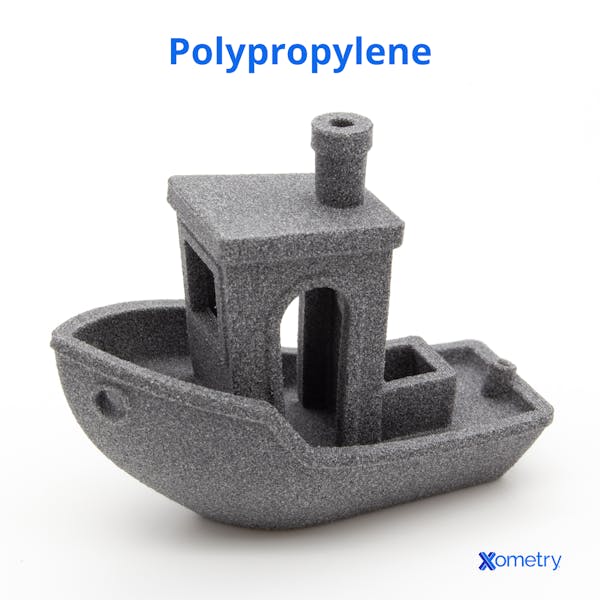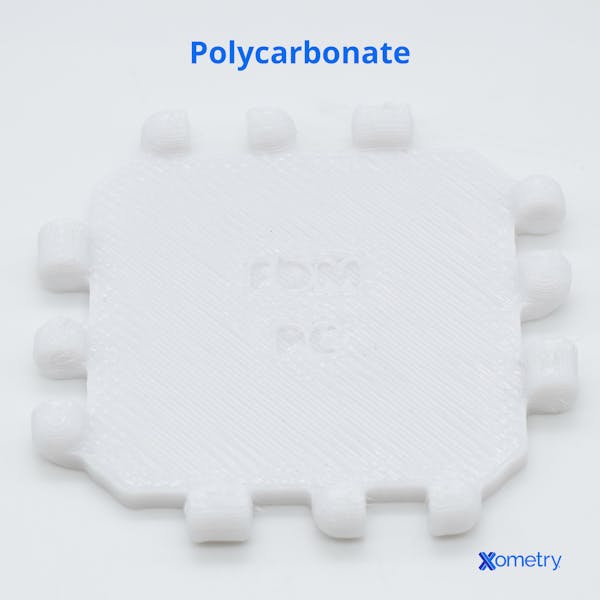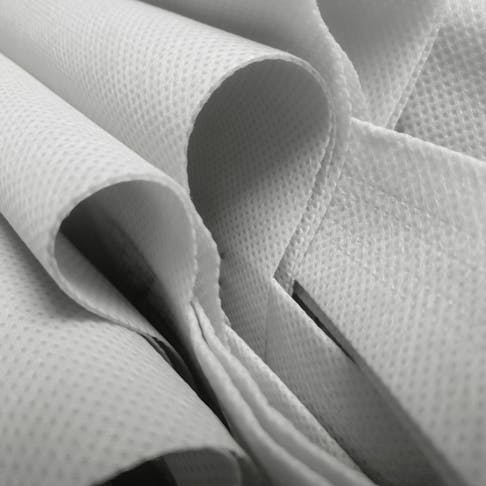Polypropylene (PP) is a thermoplastic with long chains of propylene monomer in regular strands. It is widely employed in single-use and long-life products such as packaging and rope. PP is particularly well suited to roles requiring regular chemical/oil exposure, making it a favorite in the automotive sector.
PP is a relatively soft polymer, which makes it less well-suited to high-stress and engineering applications. It possesses very good abrasion resistance and a high degree of self-lubrication behavior, making it exceedingly useful in sliding and rotating applications. It can also be rendered very transparent, by biaxial stretching (referred to as biaxially oriented PP, or BOPP)
Polycarbonate (PC) is an amorphous thermoplastic that has a similar light transmission characteristic to glass and is supplied in both opaque and colored translucent forms. It is widely used as a glass substitute for its increased durability and toughness. The material is also particularly widely used for its impact resistance, good heat resistance, and transparency. PC is commonly used for plastic lenses in automotive components, eyewear, exterior lighting fixtures, greenhouses, medical devices, and protective gear. This article will further compare polypropylene vs. polycarbonate in terms of applications, use, properties, and cost.
What is Polypropylene?
Polypropylene (PP) is a polymer that can be manufactured in various forms (showing polymorphism), with significant resulting divergence in mechanical, chemical, and thermal properties. The forms are:
- Isotactic Polypropylene (iPP or PPi): Demonstrates 30–60% crystallinity, a high melting point (above 160 °C), and wide commercial application.
- Polypropylene Fibers: These find wide application in textiles, ropes, etc.
- Atactic Polypropylene (aPP or PPa): It is a very soft elastic polymer that tears easily and crumbles in compression.
- Block Copolymer Polypropylene: Made from alternating blocks of atactic and isotactic polymer, providing crystalline regions coupled by elastic, amorphous regions.
- Syndiotactic Polypropylene (sPP or PPs): Offers a much increased electrical breakdown voltage.
- Biaxially Oriented Polypropylene (BOPP): This form has high transparency and enhanced chemical, thermal and mechanical properties.
These forms have identical chemical constituents, but the regular/irregular orientation of the monomer puts the methyl group (-CH3) to one side or the other, which significantly affects various properties. Mechanical modification then increases the alignment of chains significantly, producing another divergent group of polymorphic forms. For more information, see our guide on Polypropylene Plastic.
Figure 1 below is an example of a polypropylene part:

Polypropylene was first synthesized at Phillips Petroleum in 1951 by Paul Hogan and Robert Banks. The process was later scaled up to commercial practicality by Italian and German scientists Natta and Rehn, working in Spain, in 1954. By 1957 it was in widespread use throughout Europe and the US.
Why Polycarbonate is Used Widely
Polycarbonate is widely used because of its high durability, under stress and impact. Its low scratch resistance limits its use, but the addition of a hard coat can counter this disability, at a price. This renders it suitable for eyewear and lenses, particularly because of its relatively high refractive index of 1.58 (allowing thinner lenses for the same focal effect). Hard coats can consist of polyvinyl alcohol, modified forms of melamine, or silicates. This is a rapidly advancing technical area. For more information, see our guide on What is Polycarbonate Material.
Figure 2 is an example of polycarbonate 3D-printed part:

Polycarbonate is generally considered interchangeable with polymethylmethacrylate (PMMA, or acrylic) except that PC has markedly higher temperature tolerance. However, PMMA also has a lower refractive index (1.48), making it less optimal for optics components. Molded PC has higher visible light transmissivity than glass and is widely used as a substitute, particularly where impact resistance is beneficial.
Low molecular weight grades of PC offer better molding properties than higher weight grades but have consequently lower strength. This often requires a compromise between processing cost and toughness. Where cost is a lower priority, such as in aerospace applications (aircraft windows for example), the higher weight grades are widely employed.
The extreme toughness of a PC is valuable in many applications, and it is particularly widely used in the automotive sector. While its UV stability is relatively low (compared with PMMA), the addition of coatings and antioxidants as stabilizers increase PC’s lifetime, before yellowing. Thus vehicle light covers don’t yellow and embrittle, as they did even a decade ago. PC is particularly useful for roofing applications, being tough, relatively low cost, highly transparent in the visible spectrum, and virtually opaque to UV.
PC is also an important copolymer addition, adding strength and rigidity to a range of polymers, and improving their mechanical and thermal properties. However, PC is extremely vulnerable to attacks by oils, solvents, and organic acids, rapidly breaking down the polymer and destroying it. This property carries over into many of its copolymer uses, too, so this must be considered very carefully in the material selection stage of any potential application.
Applications of Polypropylene vs. Polycarbonate
Polypropylene and polycarbonate are in no way substitutes for each other, so it is rare to find applications that use both materials.
Listed here are the main market sectors that utilize polypropylene (PP) and its applications:
- Packaging (Products and Food): Liquid bottles (not caps), food containers, clear films, and heat-shrink films.
- Automotive: Air handling for engine and AC, interior parts, liners and mud shields, electrical insulators, and lead-acid-battery trays.
- Medical: Syringe barrels, medication containers, tubing, masks.
- Domestic/consumer Products: Household equipment for storage and liquid handling (water tanks, buckets, septic tanks), kettle and kitchen equipment bodies and handles, toothbrushes, baby equipment, pool and pond liners, garden equipment, suitcases.
- Chemical Industries: Pipelines and unstressed valve components for aggressive chemistries.
- Textiles and Carpets: Self-colored and resilient fibers for textiles, carpets, woven tarpaulins, astroturf, and non-woven fabrics for safety gear.
- Furniture: “Cast” resin garden and household furniture, decorative and low-stress cover panels in higher value furniture.
Listed here are the main market sectors that utilize polycarbonate (PC: extruded/calendered sheet, and molded items) and their applications:
- Medical Equipment: Cameras, lenses, medical aids.
- Protective Eyewear: Safety goggles, and face shields.
- Optical Components: human vision corrective and instrument lenses, light guides.
- Automotive: Light covers and lenses.
- Media Discs: Blu-ray, DVDs, etc.
- Domestic and Commercial Paneling: Cupboards, kitchen paneling, handles.
- Display Stands/weatherproofing: Advertising displays, protective covers for advertising, weather shields and barriers in public spaces, bus stops, etc.
- Armored, Vandal-Proof, and Bulletproof Windows: For vehicles and personnel protection.
- Agriculture: Greenhouse roofing/windows.
- Lightweight Luggage: Bags and suitcases.
Physical Properties of Polypropylene vs. Polycarbonate
Table 1 list the physical properties when comparing polypropylene and polycarbonate:
| Property | Polypropylene (molded or extruded material, not focused) | Polycarbonate (molded or extruded) |
|---|---|---|
Property Optical transmission | Polypropylene
(molded or extruded material, not focused) Can be high in some copolymers and in focused materials | Polycarbonate
(molded or extruded) Very high, comparable to high-quality glass, UV opaque |
Property Hardness, Rockwell R | Polypropylene
(molded or extruded material, not focused) 20–118 | Polycarbonate
(molded or extruded) 114–126 |
Property Tensile Strength, Ultimate | Polypropylene
(molded or extruded material, not focused) 9–80 MPa | Polycarbonate
(molded or extruded) 28–75 MPa |
Property Tensile Strength, Yield | Polypropylene
(molded or extruded material, not focused) 4–1350 MPa | Polycarbonate
(molded or extruded) 39–70 MPa |
Property Elongation at break | Polypropylene
(molded or extruded material, not focused) 2.4–900% | Polycarbonate
(molded or extruded) 10–138% |
Property Modulus of Elasticity | Polypropylene
(molded or extruded material, not focused) 0.08–8.25 GPa | Polycarbonate
(molded or extruded) 1.79–3.24 GPa |
Property Flexural Yield Strength | Polypropylene
(molded or extruded material, not focused) .296–180 MPa | Polycarbonate
(molded or extruded) 36–103 MPa |
Property Flexural Modulus | Polypropylene
(molded or extruded material, not focused) 0.026–10 GPa | Polycarbonate
(molded or extruded) .971–3.1 GPa |
Property Coefficient of friction | Polypropylene
(molded or extruded material, not focused) 0.25 | Polycarbonate
(molded or extruded) 0.31 |
Property Coefficient of thermal expansion | Polypropylene
(molded or extruded material, not focused) 18.0–185 µm/m-°C | Polycarbonate
(molded or extruded) 50.0–70.2 µm/m-°C |
Property Melting point | Polypropylene
(molded or extruded material, not focused) 61–221 °C | Polycarbonate
(molded or extruded) 288–316 °C |
Property Max service temperature | Polypropylene
(molded or extruded material, not focused) 65–125 °C | Polycarbonate
(molded or extruded) 115–135 °C |
Recyclability and Sustainability of Polypropylene vs. Polycarbonate
Polypropylene (PP) is manufactured from a hydrocarbon source material. No good bio-source alternative supply has been established. It is highly recyclable and, when clean and fully sorted, it is well suited for reuse. Typically, less than 1% of the PP made worldwide is recycled, however.
Polycarbonate (PC) also uses hydrocarbon source materials and considerable energy in manufacturing. It's a highly recyclable material that responds well to shredding and re-melt extrusion, to make second-grade virgin pellets. This requires very rigorous sorting to avoid random impurities, but the automotive sector has made advances in effective recycling and circular use. Very little effective recycling of PCs takes place outside the automotive sector.
Costs of Polypropylene vs. Polycarbonate
Polypropylene granules for molding, extrusion or film/fiber manufacture typically cost around $1.30 per kg. Recycled material is generally 20 to 40% cheaper, depending on grade. Polycarbonate is considerably more expensive, at around $2.80 per kg, although recycled material of near-top grade can cost as little as $1.60 per kg.
Alternative Materials to Polypropylene and Polycarbonate
Alternative material lists for polycarbonate (PC) are highly dependent on the application.
- Acrylic offers some advantages, such as better scratch resistance and lower temperature working, but it is considerably less strong. Acrylic offers good clarity, but a lower refractive index, making it suitable for windows but less so for lenses. In this case, urethane materials such as Trivex™ offer advantages.
- In lower-grade transparent applications, polystyrene (PS) offers an alternative to PC, but it is considerably weaker and very fracture prone. However, for applications such as light guides, PS can serve well.
- In many cases, ABS is a good alternative to PC, where ultimate strength and flexural resilience are less serious issues.
Polypropylene (PP) also has various alternatives, depending on the application.
- For single-use packaging, PP competes with expanded PS, high- and low-density polyethylene (PE), and PVC.
- In films and heat-shrink wrapping, alternatives are PE and to a lesser extent PVC.
- In piping and applications requiring chemical resilience, PP competes directly with both HDPE and PVC.
- In automotive applications, PP is a low-cost alternative to ABS and AES, where cosmetic considerations are outweighed by cost or the need for maximum impact resilience.
How Xometry Can Help
Xometry provides a wide range of manufacturing capabilities including CNC machining, 3D printing, injection molding, laser cutting, and sheet metal fabrication. Get your instant quote today.
Copyright and Trademark Notices
- Trivex™ is a registered trademark of PPG Industries Ohio, Inc.
Disclaimer
The content appearing on this webpage is for informational purposes only. Xometry makes no representation or warranty of any kind, be it expressed or implied, as to the accuracy, completeness, or validity of the information. Any performance parameters, geometric tolerances, specific design features, quality and types of materials, or processes should not be inferred to represent what will be delivered by third-party suppliers or manufacturers through Xometry’s network. Buyers seeking quotes for parts are responsible for defining the specific requirements for those parts. Please refer to our terms and conditions for more information.

